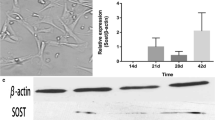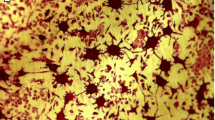Abstract
Sintered compounds prepared with β-tricalcium phosphate (β-TCP) are commonly used as biocompatible materials for bone regenerative medicine. Although implanted β-TCP is gradually replaced with new bone after resorption by osteoclasts, exactly how osteoclasts resorb β-TCP is not well understood. To elucidate this mechanism, we analyzed the structure of β-TCP discs on which mouse mature osteoclasts were cultured using scanning electron microscopy. We found that β-TCP was resorbed by mature osteoclasts on one side of each disc, as evidenced by the formation of multiple spine-like crystals at the exposed areas. Because osteoclasts secrete acid to resorb bone minerals, we mimicked this acidification by dipping β-TCP slices into HCl solution (pH 2.0). However, no spine-like crystals appeared even though the size of each β-TCP particle was reduced. On dentin slices, osteoclasts formed clear actin rings, which are cytoskeletal structures characteristic of bone-resorbing osteoclasts. No clear actin rings were observed in osteoclasts cultured on β-TCP slices, although small actin dots were observed. Analysis by transmission electron microscopy showed that osteoclasts attached to β-TCP particles. These results suggest that osteoclasts resorb β-TCP particles independently of clear actin ring formation.





Similar content being viewed by others
References
Blair HC, Teitelbaum SL, Ghiselli R, Gluck S (1989) Osteoclastic bone resorption by a polarized vacuolar proton pump. Science 245:855–857
Chazono M, Tanaka T, Komaki H, Fujii K (2004) Bone formation and bioresorption after implantation of injectable β-tricalcium phosphate granules-hyaluronate complex in rabbit bone defects. J Biomed Mater Res A 70:542–549
Inaoka T, Bilbe G, Ishibashi O, Tezuka K, Kumegawa M, Kokubo T (1995) Molecular cloning of human cDNA for cathepsin K: novel cysteine proteinase predominantly expressed in bone. Biochem Biophys Res Commun 206:89–96
Linovitz RJ, Peppers TA (2002) Use of an advanced formulation of β-tricalcium phosphate as a bone extender in interbody lumbar fusion. Orthopedics 25:s585–s589
Liu B, Lun DX (2012) Current application of β-tricalcium phosphate composites in orthopaedics. Orthop Surg 4:139–144
Murakami H, Takahashi N, Sasaki T, Udagawa N, Tanaka S, Nakamura I, Zhang D, Barbier A, Suda T (1995) A possible mechanism of the specific action of bisphosphonates on osteoclasts: tiludronate preferentially affects polarized osteoclasts having ruffled borders. Bone 17:137–144
Nakamura I, Gailit J, Sasaki T (1996a) Osteoclast integrin αVβ3 is present in the clear zone and contributes to cellular polarization. Cell Tissue Res 286:507–515
Nakamura I, Takahashi N, Sasaki T, Jimi E, Kurokawa T, Suda T (1996b) Chemical and physical properties of the extracellular matrix are required for the actin ring formation in osteoclasts. J Bone Miner Res 11:1873–1879
Ogose A, Hotta T, Hatano H, Kawashima H, Tokunaga K, Endo N, Umezu H (2002) Histological examination of β-tricalcium phosphate graft in human femur. J Biomed Mater Res 63:601–604
Sagawa H, Itoh S, Wang W, Yamashita K (2010) Enhanced bone bonding of the hydroxyapatite/β-tricalcium phosphate composite by electrical polarization in rabbit long bone. Artif Organs 34:491–497
Salo J, Lehenkari P, Mulari M, Metsikko K, Väänänen HK (1997) Removal of osteoclast bone resorption products by transcytosis. Science 276:270–273
Sasaki T, Watanabe C (1995) Stimulation of osteoinduction in bone wound healing by high-molecular hyaluronic acid. Bone 16:9–15
Suzuki H, Nakamura I, Takahashi N, Ikuhara T, Matsuzaki K, Isogai Y, Hori M, Suda T (1996) Calcitonin-induced changes in the cytoskeleton are mediated by a signal pathway associated with protein kinase A in osteoclasts. Endocrinology 137:4685–4690
Author information
Authors and Affiliations
Corresponding author
Rights and permissions
About this article
Cite this article
Matsunaga, A., Takami, M., Irié, T. et al. Microscopic study on resorption of β-tricalcium phosphate materials by osteoclasts. Cytotechnology 67, 727–732 (2015). https://doi.org/10.1007/s10616-015-9854-0
Received:
Accepted:
Published:
Issue Date:
DOI: https://doi.org/10.1007/s10616-015-9854-0




